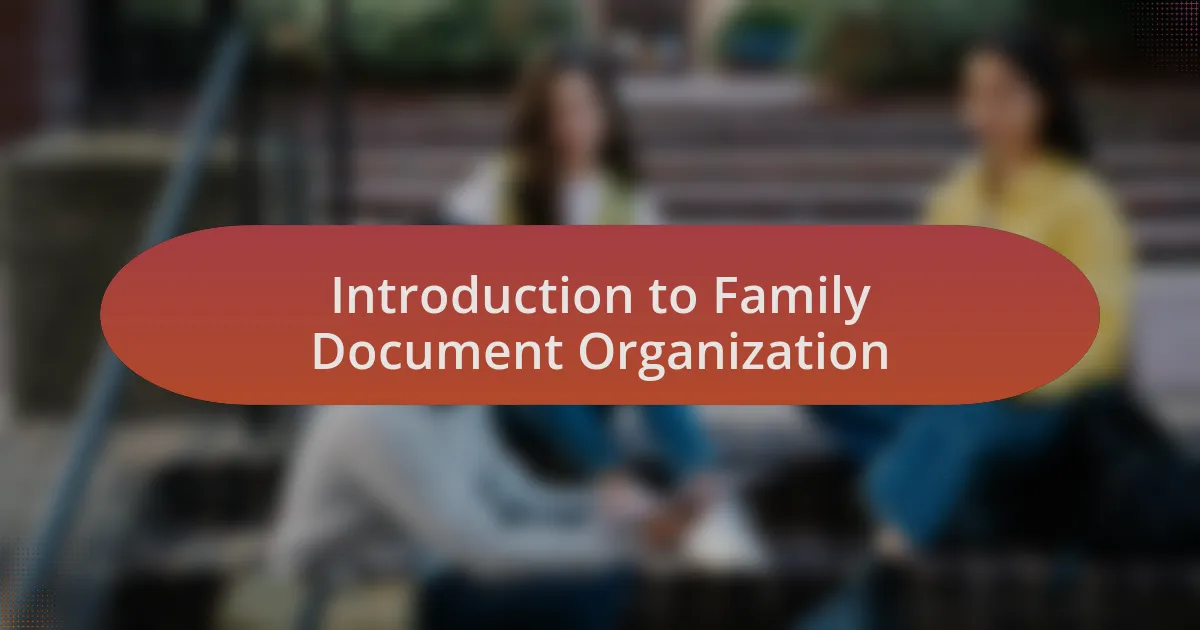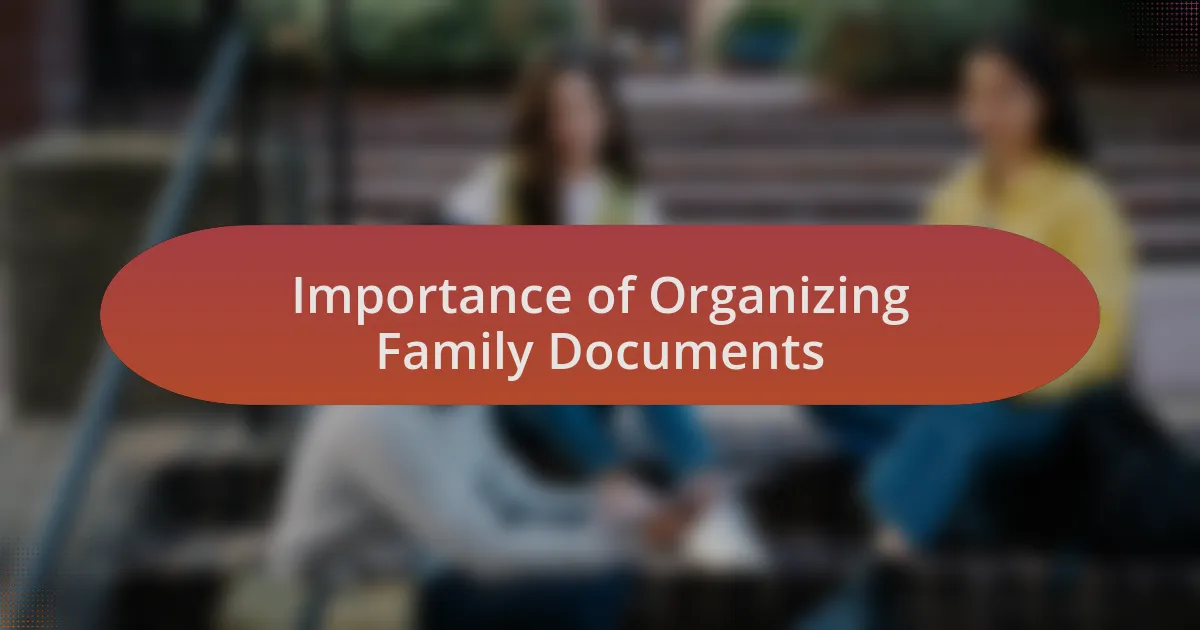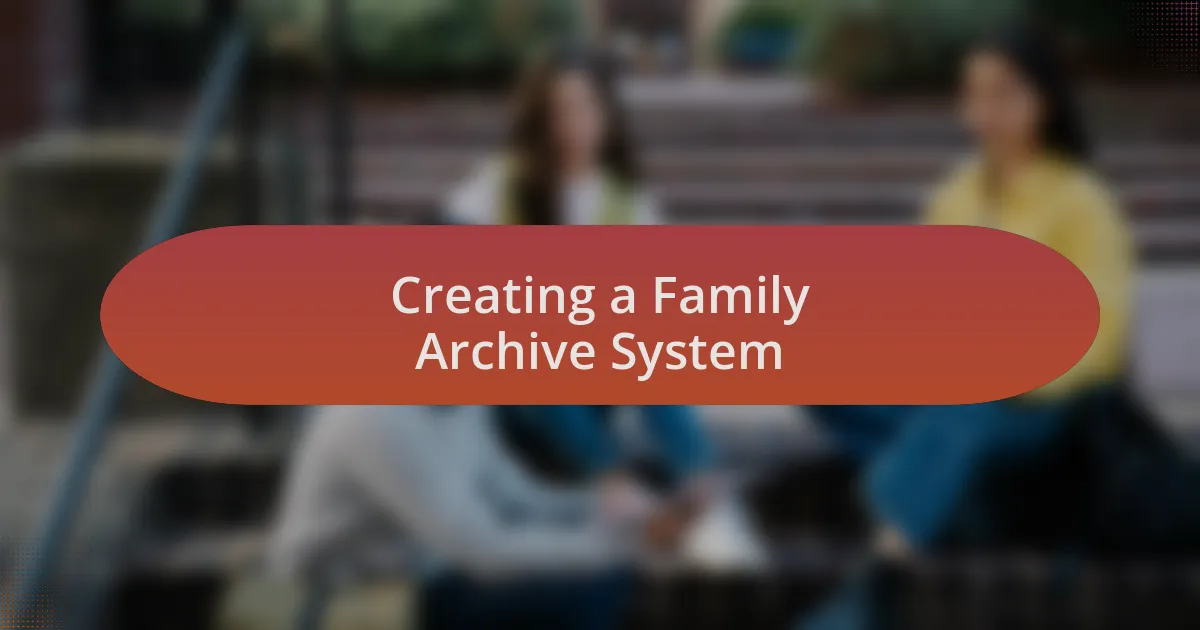Key takeaways:
- Organizing family documents preserves heritage and strengthens connections with the past, benefiting both current and future generations.
- Creating clear categories and using color-coding simplifies the organization process and helps visualize family relationships.
- Implementing a digital backup system is crucial for safeguarding family history and ensuring easy access to important documents.
- Establishing a systematic approach for both physical and digital archives enhances the documentation and storytelling of family legacies.

Introduction to Family Document Organization
Organizing family documents can seem daunting, but I’ve found it to be a rewarding journey. Imagine diving into boxes of memories—old letters, photographs, and official records—each piece tells a story waiting to be uncovered. Have you ever considered what treasures might be hiding in those stacks?
When I first started organizing my family’s documents, I was overwhelmed by the sheer volume. It felt like I was facing a mountain of paper. I remember sitting on the floor, surrounded by folders, and realizing that each item had significance, not just to me, but to future generations. This realization motivated me to create a systematic approach that made the task feel less like a chore and more like a meaningful project.
As I gradually sorted through everything, I discovered a new sense of connection with my family’s past. Creating categories and labeling sections helped me visualize the family’s history more clearly. I often wondered, how would my descendants feel if they could hold these documents in their hands someday? This thought encouraged me to be meticulous, ensuring every piece was preserved for those who come after.

Importance of Organizing Family Documents
Organizing family documents is crucial for preserving our heritage. I once stumbled upon my grandmother’s marriage certificate, tucked away in a faded envelope. It struck me then how these documents serve as a bridge to the past, helping us understand our roots. Have you ever thought about how each record can spark conversations among family members, bringing stories to life?
In my own experience, having organized documents at hand has simplified the storytelling process during family gatherings. I remember sharing a photo album during a family reunion, and it triggered a cascade of memories that strengthened our bonds. It makes me wonder—what memories could you uncover just by digging through a box? Each document you organize isn’t just a piece of paper; it’s a reminder of the love, struggles, and triumphs that shaped your family’s journey.
Furthermore, a well-organized collection of family documents can be invaluable for future research, whether it’s tracing genealogy or preserving family history for younger generations. I recall attending a local genealogy workshop where participants marveled at how accessible their family trees became once they had everything in order. Have you ever considered how your organized documents could spark a newfound interest in your family’s history for the next generation? These records are not only vital for research but also a way to ignite curiosity and pride in where we come from.

Strategies for Document Categorization
When it comes to categorizing family documents, I find that creating clear and distinct categories is key. Personally, I started with broad headings like “Births,” “Marriages,” and “Deaths.” Each category evolved to include subcategories based on location or timeframe, resembling a family tree in itself. Have you ever noticed how organizing by life events can help you connect the dots between relatives? It’s akin to assembling pieces of a puzzle, revealing relationships you might not have realized existed.
Color-coding is another strategy I’ve found effective in my own organizational system. I assigned different colors to each category, which not only makes it visually appealing but also allows for quick identification. One afternoon, I shared this method with my sister, who appreciated how effortless it became to locate her own documents when she needed them. Have you thought about how a simple color scheme could save you time when searching for important records?
I also advocate for a digital backup of important documents. My experience taught me the hard way after losing some physical papers in a flood; having digital copies salvaged memories that could have been lost. Now, I make it a habit to scan and upload documents to a secure cloud storage system. How comforting would it be to know that even if something were to happen, your family history is preserved and accessible? This blend of physical and digital organization not only secures precious information but makes sharing it with family effortless.

Tips for Digital Document Management
Maintaining an organized digital document management system is essential for protecting your family history. I once faced the daunting task of sifting through hundreds of files scattered across multiple devices. By using a consistent naming convention, such as “LastNameFirstNameTypeOfDocument_Date,” I found it much easier to find specific records quickly. Have you considered how a simple system like this can categorize your family’s stories in an orderly way?
Another practice that has greatly benefited me is regularly reviewing and deleting files I no longer need. I remember a time when my digital storage was filled with duplicates and outdated documents. It felt overwhelming! Now, I dedicate a few minutes each month to clean up my files. This routine keeps my digital space uncluttered and makes finding important documents feel seamless. Isn’t it satisfying to open your folders and see only what truly matters?
I also recommend leveraging software or apps designed for document management. I started using one that lets me tag documents with keywords, which took my organizational efforts to another level. This means I can search for any family member or event and retrieve the related documents in seconds, all while feeling empowered by the streamlined process. Have you experimented with technology to enhance your document management? It can transform how you interact with your genealogy research.

Creating a Family Archive System
When creating a family archive system, I found it helpful to start with physical documents first. I invested in high-quality folders and labeled each one based on categories like “Birth Certificates” or “Family Stories.” The act of physically sorting through these treasured papers was an emotional journey for me. I discovered letters that transported me back to moments long forgotten. Doesn’t holding a piece of your family’s history in your hands just feel special?
Moving to the digital realm, I realized that organizing my archives needed a thoughtful approach, too. I created a main folder on my computer named “Family Archives” and nested subfolders for each branch of the family tree. It was fascinating to see how each family’s story intertwined like a tapestry. Have you thought about how visualizing these connections can deepen your understanding of your heritage?
Finally, I recommend setting up a backup system to protect these irreplaceable memories. I remember the panic of losing important documents during a computer crash; it was a wake-up call! Now, I use both external hard drives and cloud storage, ensuring my family history is safe regardless of what happens. Isn’t it comforting to know your family’s legacy is securely preserved for future generations?